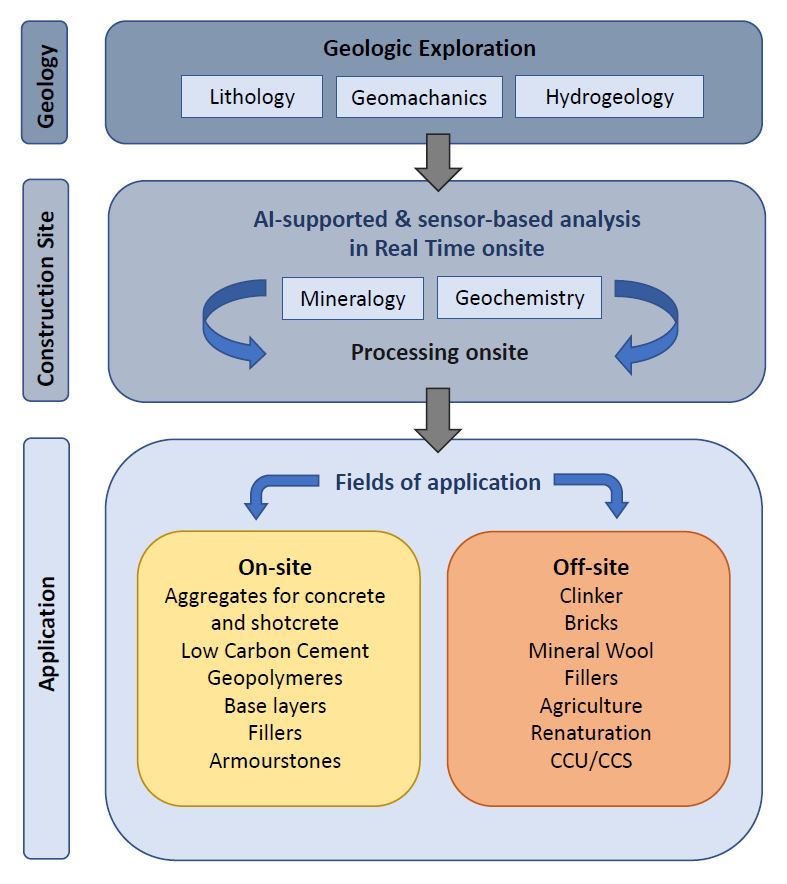NNATT - Sustainable use of excavated materials from civil engineering and tunnelling using sensor-based technologies
Short Description
Status
ongoing (2024 - 2027)
Initial situation, content and expected results
With around 42 million tonnes per year, excavated materials account for almost 60 % of Austria's waste production, of which 73 % is landfilled and only 8 % is sent to treatment plants. Most of the output streams are put to low-value use, e.g. backfilling. At the same time, 55 million tonnes per year of natural mineral resources are extracted in Austria. The reasons for this discrepancy are the challenges in material disposition, but also the cheap landfilling of uncontaminated excavated materials. The use of excavated materials therefore represents an unused contribution to the circular economy, which is particularly noticeable in the conservation of domestic resources and in the minimisation of CO2 emissions from civil engineering projects.
The NNATT project aims for a holistic system for the sustainable use of excavated materials from civil engineering and tunnelling, which spans from geologic exploration over construction process technology to recycling (fig. 1). The basis sets an AI-based decision matrix, with which excavated materials are separated in real-time based on available mineralogical and geotechnical information from the preliminary geological exploration of a civil engineering or tunnelling project, in combination with AI-supported and sensor-based analyses. From the material flows generated in this way customised products are developed based on requirements of the industry, which are used directly on the construction site or passed on to external customers. In addition, these products meet today's requirements with regard to the reduction of CO2 emissions and the applicable standards regarding sustainable construction.
Sensor-based methods are already used as standard for the classification and sorting of anthropogenic and geogenic resources for municipal waste and in ore mining and are also becoming increasingly important for construction waste. In civil engineering and tunnelling, technologies such as Hyper-Specs, Raman and LIBS, which have not yet been introduced, but can enable a decisive breakthrough in the recycling of excavated materials. This material flow characterisation is primarily based on chemical and mineralogical parameters, which are linked to parameters relevant to recycling in a highly complex way. One challenge in the utilisation of excavated materials is to evaluate this complexity in a real-time analysis. This is where the application of AI offers an immense advantage. However, AI has not yet found its way into civil engineering projects, so this field harbours great potential for application.
In addition to on-site applications as aggregate for concrete and shotcrete, bound and unbound base layers, backfilling and as low carbon cement, depending on the particle size, off-site applications such as in insulating materials (mineral wool, sample concrete), ceramic building materials (bricks, clinker), inorganic binders (cement, geopolymers), fillers (for plastics and paper) and topsoil material for agriculture, greening of infrastructure projects and renaturation measures are feasible as well. The utilisation of excavated material makes a major contribution to ecological sustainability through a significant reduction in transport emissions and the use of CO2-free Ca-bearing raw materials. A life-cycle assessment (LCA) will point out these advantages in detail.
Project Partners
Project lead
Robert Galler
Lehrstuhl für Subsurface Engineering, Montanuniversität Leoben
Project partners
- Andreas Meyer
Agir Austria GmbH - Daniel-Eduardt Sandu
AiDEXA GmbH - Mark Ganster
Austin Powder - Adolf Merl
Daxner & Merl GmbH - Mathieu Pillet
Edaphos Engineering - Volker Mörkens
LSA – Laser Analytical Systems & Automation GmbH - Roland Mayr
Master Builders Solution GmbH - Stefan Tödtling
ÖBB Infrastruktur AG - Roman Lackner
Universität Innsbruck
Contact Address
Robert Galler
Lehrstuhl für Subsurface Engineering, Montanuniversität Leoben
Franz-Josef-Straße 18, 8700 Leoben
E-Mail: robert.galler@unileoben.ac.at

